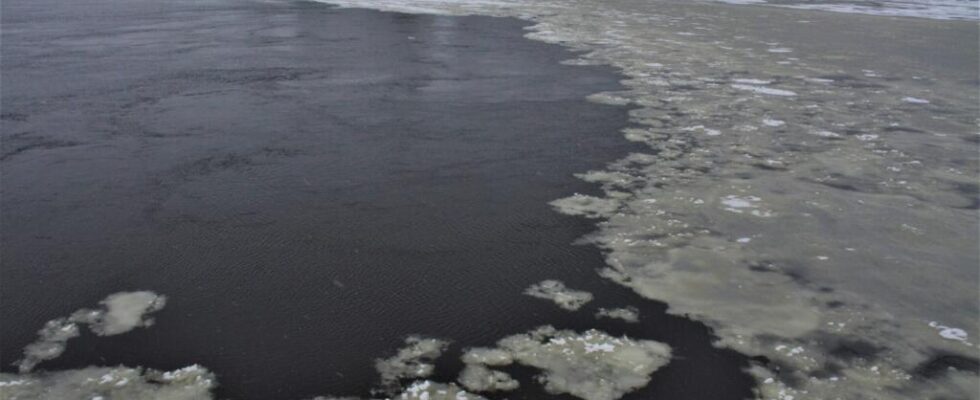Hit hard by climate change combined with a multi-decadal meteorological phenomenon, the American-Canadian Great Lakes are less and less permanently covered by ice. Like them, the St. Lawrence River and its tributaries struggle to freeze, causing upheavals in ecosystems and human beings.
The totally frozen Canadian-American Lake Erie, houses whose icy doors no longer open, an intense blizzard… 2022 christmas storm pictures in North America, particularly on the border between Canada and the United States, have traveled around the world. However, they are far from corresponding to a dramatic trend observed in recent decades: the ice covers less and less the fresh waters of the region.
If climate change accentuates these extreme climatic phenomena, it causes global warming from which the Great Lakes suffer. Thus, the same Lake Erie had, at the beginning of February 2023, an ice cover of approximately 12%. On average, for this period, it should be just over 55%. He is not the only one concerned: Lake Ontario was covered with 3% ice at the beginning of the month while its climatological average is nearly 16%. ” The number of years of low ice cover is much more common after the winter of 1997/1998 than before “, specifies the Canadian Ice Service in a written response.
The St. Lawrence River is also affected. The emissary of the Great Lakes is less and less covered by ice, causing upheavals in a region that extends over more than 2000 km, from Chicago to Gaspé.
Unprecedented climatic conditions
The absence of ice on the Great Lakes is already having an impact on the surrounding climate itself. Indeed, when a disturbance arrives above a body of frozen water, it cannot recharge as much as it would if the ice were absent. Except that now that the Great Lakes are freezing less and less, the disturbances are getting stronger as they pass over them. ” This is what we have seen in southern Ontario twice this winter. The systems that arrive from western Canada, from Alberta or even from the foothills of the Rocky Mountains at the level of Utah for example, gather above the Great Lakes and no longer weaken as before, which accentuates the precipitation.explains Patrick de Bellefeuille, climate specialist at Météomédia.
The origin of these upheavals is twofold. Warming linked to human activities and the multi-decadal oscillation of the Atlantic, a natural warming which is spread over thirty years. ” These two trends have acted together and been amplified over the past three decades, leading to a lower level of ice cover than before 1998. », explains Jia Wang, climatologist at the Great Lakes Environmental Research Laboratory. While the second trend, a natural and cyclical cause, should eventually reverse, the first, of anthropogenic origin, should only increase, which does not bode well. good for the ice cover of these regions.
Disrupted activities and ecosystems
However, the reduction in the ice cover of the Great Lakes and the St. Lawrence has a major impact on ecosystems. The ice protects the shoreline from erosion and the juvenile fish from disturbance by wind and waves. ” Less ice means a lower survival rate for some aquatic animals “Warns Jia Wang, before adding:” Extremely low ice cover, as has happened seven times since 1998 – compared to 2 times before 1998 – will therefore have a long-term impact on the lakes food web and on ecosystem changes. “. Higher water temperature also leads to the proliferation of certain invasive species. The quagga mussel, favored by abnormal temperatures, has invaded Lake Michigan for the past thirty years.
Like ecosystems, people are affected. The economic sector is thus directly affected by this weak ice cover. Ice fishing, like other tourist and traditional activities, is struggling to survive on a large part of the Great Lakes and their tributaries. Ottawa’s Rideau Canal Skateway did not open this year for the first time in its history. ” There are many people who live in Quebec’s hydrographic networks, the Rideau Canal or the L’Assomption River for example, and who have not had the thickness of ice required to secure snowmobile trails or the practice of White peach “confirms Patrick de Bellefeuille.
Arrival at the Port of Montreal: use of a tug as an ice barrier. My colleague performs the maneuver in the company of the captain. pic.twitter.com/15UjN1ZMRx
— Simon Lebrun (@LebrunSimon) February 23, 2023
The disappearance of the ice can be a benefit for human beings. Icebreakers, for example, go out much less often than before. Port maneuvers are avoided and flooding linked to melting ice should be less intense this year. Rare positive gains for an upheaval whose consequences are only beginning to be felt.
